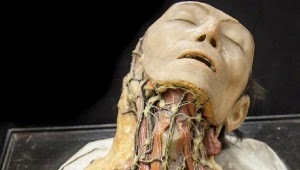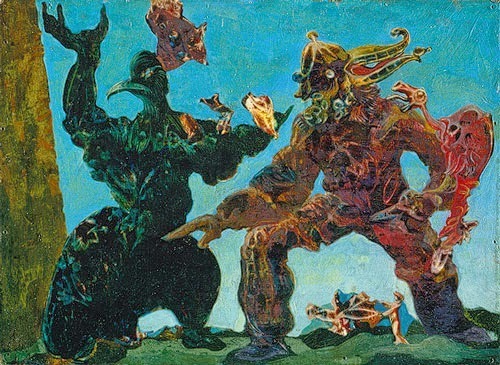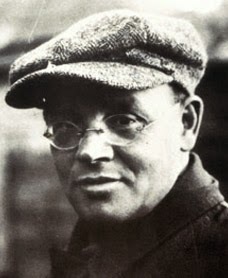Michael Swanwick's Blog, page 137
February 4, 2015
A Memoir in the Form of Four Denim Jackets (Part 3)
.

In the Eighties, I was both married and published. So I needed a denim jacket more in keeping with my more dignified state. Marianne took a new jacket and bleached the Milky Way across it. Then she embroidered stars on the back in the pattern of the Northern Cross -- the constellation also known as Cygnus, the Swan.

The Guinness shoulder patch I had bought in Ireland in 1982, the first time I had ever been overseas. Above one pocket are a cloisonne button of Fat Freddy's Cat, another for Solar Energy (I was working for the National Solar Heating and Cooling Information Center at the time), and a handmade "Cool Runnings" wooden button which I had bought in Jamaica. Over the other pocket was a NASA patch -- I was a sponsor, not a participant. The black-and-white button was for Philadelphia's Mythos Festival, a city-wide celebration of myth that Marianne and I both enjoyed the hell out of. I wore it upside down to symbolize my intention to turn mythology on its head.
The braided string had significance, I know, but what it was I have long forgotten.
I used to call this jacket "my SFWA colors."
*

In the Eighties, I was both married and published. So I needed a denim jacket more in keeping with my more dignified state. Marianne took a new jacket and bleached the Milky Way across it. Then she embroidered stars on the back in the pattern of the Northern Cross -- the constellation also known as Cygnus, the Swan.

The Guinness shoulder patch I had bought in Ireland in 1982, the first time I had ever been overseas. Above one pocket are a cloisonne button of Fat Freddy's Cat, another for Solar Energy (I was working for the National Solar Heating and Cooling Information Center at the time), and a handmade "Cool Runnings" wooden button which I had bought in Jamaica. Over the other pocket was a NASA patch -- I was a sponsor, not a participant. The black-and-white button was for Philadelphia's Mythos Festival, a city-wide celebration of myth that Marianne and I both enjoyed the hell out of. I wore it upside down to symbolize my intention to turn mythology on its head.
The braided string had significance, I know, but what it was I have long forgotten.
I used to call this jacket "my SFWA colors."
*
Published on February 04, 2015 14:05
February 3, 2015
Thane of Ursus Major
.

George Martin may have his Iron Throne.
But I have the Chair of Bear!
Above: Credit photo to Marianne C. Porter.
*

George Martin may have his Iron Throne.
But I have the Chair of Bear!
Above: Credit photo to Marianne C. Porter.
*
Published on February 03, 2015 11:58
February 2, 2015
Frankenstein Reborn
.

If you've been paying attention to this blog -- and in this one instance, if in no other, you should -- you know that I think that local actor Josh Hitchens is a living cultural treasure. Since 2011, he's been writing and putting on a series of one-man performances ranging of Dracula, Sleepy Hollow, Jeffrey Dahmer and other dark classics.
So when it was announced that he would be performing his own abridgment of Frankenstein at the Mütter Museum (one of the world's foremost collections of medical anomalies) for one night only, it seemed a match made in some dark heaven. I bought tickets immediately, which was a good thing because the show, predictably, sold out quickly.
Museum Director Robert D. Hicks opened the evening with a nineteenth-century lecture (in period costume) on electricity and the human body. Having heard many medical presentations in my time, I can attest that it was tone-perfect: Informative, lucid, straightforward, modest -- and, as medical history has since proved, wrong in many respects.
Hitchens then took over, presenting a Frankenstein with the Hollywood's additions scraped off, one that began in the Arctic wastes, revealed the self-deluding nature of Victor's ambitions, and presented the Creature with horror and unalloyed sympathy. I cannot be the only person to leave the evening determined to reread Mary Shelley's masterpiece as soon as possible.
Josh Hitchens' performance was, as always, absolutely compelling. By limiting the audience to a small enough number that nobody was ever peering over anybody else's shoulder, he was able to connect more viscerally with us all. We were all caught in the magnetic field of his performance, and it was almost impossible to look away. There in the liminal space where acting and storytelling overlap something special occurs. It's an experience unlike any other.
Frankenstein was performed in a number of rooms within the Mütter, making the museum itself almost a second performer. Victor Frankenstein becomes more monstrous when he is explaining his ambitions while standing alongside a display case containing the skeleton of Siamese twins. His creation seems far more plausible presented in the context of Nineteenth Century medicine.
It was a wonderfully gothic evening. Let's hope the Mütter Museum sponsors it again someday. If it does, I'll be sure to let you know.
Above (text): Before you call me on an error, allow me to stipulate that I consider Josh Hitchen's Jeffrey Dahmer something of an instant classic. You would too, had you seen it.
*

If you've been paying attention to this blog -- and in this one instance, if in no other, you should -- you know that I think that local actor Josh Hitchens is a living cultural treasure. Since 2011, he's been writing and putting on a series of one-man performances ranging of Dracula, Sleepy Hollow, Jeffrey Dahmer and other dark classics.
So when it was announced that he would be performing his own abridgment of Frankenstein at the Mütter Museum (one of the world's foremost collections of medical anomalies) for one night only, it seemed a match made in some dark heaven. I bought tickets immediately, which was a good thing because the show, predictably, sold out quickly.
Museum Director Robert D. Hicks opened the evening with a nineteenth-century lecture (in period costume) on electricity and the human body. Having heard many medical presentations in my time, I can attest that it was tone-perfect: Informative, lucid, straightforward, modest -- and, as medical history has since proved, wrong in many respects.
Hitchens then took over, presenting a Frankenstein with the Hollywood's additions scraped off, one that began in the Arctic wastes, revealed the self-deluding nature of Victor's ambitions, and presented the Creature with horror and unalloyed sympathy. I cannot be the only person to leave the evening determined to reread Mary Shelley's masterpiece as soon as possible.
Josh Hitchens' performance was, as always, absolutely compelling. By limiting the audience to a small enough number that nobody was ever peering over anybody else's shoulder, he was able to connect more viscerally with us all. We were all caught in the magnetic field of his performance, and it was almost impossible to look away. There in the liminal space where acting and storytelling overlap something special occurs. It's an experience unlike any other.
Frankenstein was performed in a number of rooms within the Mütter, making the museum itself almost a second performer. Victor Frankenstein becomes more monstrous when he is explaining his ambitions while standing alongside a display case containing the skeleton of Siamese twins. His creation seems far more plausible presented in the context of Nineteenth Century medicine.
It was a wonderfully gothic evening. Let's hope the Mütter Museum sponsors it again someday. If it does, I'll be sure to let you know.
Above (text): Before you call me on an error, allow me to stipulate that I consider Josh Hitchen's Jeffrey Dahmer something of an instant classic. You would too, had you seen it.
*
Published on February 02, 2015 13:48
January 30, 2015
Celebrating Chip Delany
.

I was seventeen when I first read The Einstein Intersection. It was an important book for me. Its author, Samuel R. Delany, was only twenty-five when he wrote it and already he was transforming the genre of science fiction. It is hard to exaggerate the influence he has had on us all.
So when Nisi Shawl asked me to contribute to a festschrift in Delany's honor, there was only one response I could make.
Stories for Chip: A Tribute to Samuel R. Delany, edited by Nisi and Bill Campbell, will be published in July by Rosarium Publishing. It contains stories and essays in Chip's honor.
Here, in alphabetical order by author, is the table of contents:
Christopher Brown Festival
Chesya Burke For Sale: Fantasy Coffin
Roz Clarke Haunt-type Experience
Kathryn Cramer Characters in the Margins of a Lost Notebook
Vincent Czyz Hamlet's Ghost Sighted in Frontenac, KS
Junot Díaz Nilda
Geetanjali Dighe The Last Dying Man
L. Timmel Duchamp Real Mothers, a Faggot Uncle, and the Name of the Father: Samuel R. Delany's Feminist Revisions of the Story of SF
Hal Duncan An Idyll in Erewhyna
Fabio Fernandes Eleven Stations
Jewelle Gomez Be Three
Eileen Gunn Michael Swanwick and Samuel R. Delany at the Joyce Kilmer Service Area, March 2005
Nick Harkaway Billy Tumult
Ernest Hogan Guerilla Mural of a Siren's Song
Nalo Hopkinson & Nisi Shawl Jamaica Ginger
Walidah Imarisha Walking Science Fiction: Samuel Delany and Visionary Fiction
Alex Jennings Heart of Brass
Tenea D. Johnson Each Star a Sun to Invisible Planets
Ellen Kushner Delany Story
Claude Lalumiere Empathy Evolving as a Quantum of Eight-Dimensional Perception
Isiah Lavender Delany Encounters
devorah major Voice Prints
Anil Menon Clarity
Carmelo Rafala Song for the Asking
Kit Reed Kickenders
Kim Stanley Robinson Introduction
Benjamin Rosenbaum The First Gate of Logic
Geoff Ryman Capitalism in the 22nd Century
Alex Smith Clones
Michael Swanwick On My First Reading of The Einstein Intersection
Sheree Renee Thomas River Clap Your Hands
Kai Ashante Wilson "Legendaire"
So now you know whether you need this book or not. I'm a big fan of books where you can say that.
You can find the Rosarium Publishing site here.
*

I was seventeen when I first read The Einstein Intersection. It was an important book for me. Its author, Samuel R. Delany, was only twenty-five when he wrote it and already he was transforming the genre of science fiction. It is hard to exaggerate the influence he has had on us all.
So when Nisi Shawl asked me to contribute to a festschrift in Delany's honor, there was only one response I could make.
Stories for Chip: A Tribute to Samuel R. Delany, edited by Nisi and Bill Campbell, will be published in July by Rosarium Publishing. It contains stories and essays in Chip's honor.
Here, in alphabetical order by author, is the table of contents:
Christopher Brown Festival
Chesya Burke For Sale: Fantasy Coffin
Roz Clarke Haunt-type Experience
Kathryn Cramer Characters in the Margins of a Lost Notebook
Vincent Czyz Hamlet's Ghost Sighted in Frontenac, KS
Junot Díaz Nilda
Geetanjali Dighe The Last Dying Man
L. Timmel Duchamp Real Mothers, a Faggot Uncle, and the Name of the Father: Samuel R. Delany's Feminist Revisions of the Story of SF
Hal Duncan An Idyll in Erewhyna
Fabio Fernandes Eleven Stations
Jewelle Gomez Be Three
Eileen Gunn Michael Swanwick and Samuel R. Delany at the Joyce Kilmer Service Area, March 2005
Nick Harkaway Billy Tumult
Ernest Hogan Guerilla Mural of a Siren's Song
Nalo Hopkinson & Nisi Shawl Jamaica Ginger
Walidah Imarisha Walking Science Fiction: Samuel Delany and Visionary Fiction
Alex Jennings Heart of Brass
Tenea D. Johnson Each Star a Sun to Invisible Planets
Ellen Kushner Delany Story
Claude Lalumiere Empathy Evolving as a Quantum of Eight-Dimensional Perception
Isiah Lavender Delany Encounters
devorah major Voice Prints
Anil Menon Clarity
Carmelo Rafala Song for the Asking
Kit Reed Kickenders
Kim Stanley Robinson Introduction
Benjamin Rosenbaum The First Gate of Logic
Geoff Ryman Capitalism in the 22nd Century
Alex Smith Clones
Michael Swanwick On My First Reading of The Einstein Intersection
Sheree Renee Thomas River Clap Your Hands
Kai Ashante Wilson "Legendaire"
So now you know whether you need this book or not. I'm a big fan of books where you can say that.
You can find the Rosarium Publishing site here.
*
Published on January 30, 2015 07:40
January 29, 2015
A Memoir in the Form of Four Denim Jackets (Part 2)
.

This denim jacket isn't even mine. It belonged to a young woman I met when worked as a Clerk-Typist 1 for the Commonwealth of Pennsylvania Department of Health Bureau of Laboratories. At the time it was located in Landis, an old tuberculosis hospital in Philadelphia. Marianne Catherine Porter was an interesting woman. She was trained as a marine biologist and worked for the Bureau as microbiologist. The patches on her hacking-about jacket were for various bird sanctuaries she'd visited, including one in Trinidad and Tobago. Not visible in this photo is a patch on one sleeve for the Space Shuttle, which she had seen in transit.
Marianne was smart, witty, and had a variety of interests. She was exactly the sort of person I wanted to have for a friend. So what is her jacket doing in my closet?
Reader, I married her.
Above: I like to tell people we met in a TB hospital. It sounds more romantic that way.
*

This denim jacket isn't even mine. It belonged to a young woman I met when worked as a Clerk-Typist 1 for the Commonwealth of Pennsylvania Department of Health Bureau of Laboratories. At the time it was located in Landis, an old tuberculosis hospital in Philadelphia. Marianne Catherine Porter was an interesting woman. She was trained as a marine biologist and worked for the Bureau as microbiologist. The patches on her hacking-about jacket were for various bird sanctuaries she'd visited, including one in Trinidad and Tobago. Not visible in this photo is a patch on one sleeve for the Space Shuttle, which she had seen in transit.
Marianne was smart, witty, and had a variety of interests. She was exactly the sort of person I wanted to have for a friend. So what is her jacket doing in my closet?
Reader, I married her.
Above: I like to tell people we met in a TB hospital. It sounds more romantic that way.
*
Published on January 29, 2015 08:39
January 28, 2015
Dogfight -- the Movie
.

Nothing is ever certain in the film industry, but it looks like the movie version of "Dogfight" might actually get made.
"Dogfight," for those who don't know, is a story I co-wrote with William Gibson long, long ago. How long ago? So long ago that when it was published my name came before Bill's. He was still working on Neuromancer then, and we were both all but unknown.
Now director Simon Pummell is writing the script for his version of the story. This is not going to be a big Hollywood production -- and that's a good thing. Most of those movies, I can call the plot twists before they happen. Pummel is essentially an art movie guy and a BAFTA winner. I have no idea what he intends to do with the story.
So I've got my fingers crossed on this one. Because I really want to find out.
You can read about it here.
*

Nothing is ever certain in the film industry, but it looks like the movie version of "Dogfight" might actually get made.
"Dogfight," for those who don't know, is a story I co-wrote with William Gibson long, long ago. How long ago? So long ago that when it was published my name came before Bill's. He was still working on Neuromancer then, and we were both all but unknown.
Now director Simon Pummell is writing the script for his version of the story. This is not going to be a big Hollywood production -- and that's a good thing. Most of those movies, I can call the plot twists before they happen. Pummel is essentially an art movie guy and a BAFTA winner. I have no idea what he intends to do with the story.
So I've got my fingers crossed on this one. Because I really want to find out.
You can read about it here.
*
Published on January 28, 2015 10:45
January 26, 2015
A Memoir in the Form of Four Denim Jackets (Part 1)
.

I'm never going to write an autobiography. But while cleaning out the downstairs closet, I unearthed four denim jackets from my past. Here's the first:
The Seventies:
I came to Philadelphia in the winter of 1973 with fifty dollars in my pocket, a two-pack-a-day habit, and a friend who was willing to let me crash on his couch. By the time I found a job that spring, I'd lost forty pounds.
 But I've written about that elsewhere. This jacket was from slightly later, when things were getting better. I had no beard in those day and hair down below my shoulders. I ran with a scruffy batch of art students, musicians, underachievers, and the like. Collectively, we had a thousand shifts for getting by. One of my friends embroidered mandalas on the backs of blue denim jackets and sold them to a boutique, where their prices were jacked sky-high. She offered to make one for me, and I requested she embroider one of my dragons instead. I wore black denim then because I was in my early twenties and more than a little Byronic.
But I've written about that elsewhere. This jacket was from slightly later, when things were getting better. I had no beard in those day and hair down below my shoulders. I ran with a scruffy batch of art students, musicians, underachievers, and the like. Collectively, we had a thousand shifts for getting by. One of my friends embroidered mandalas on the backs of blue denim jackets and sold them to a boutique, where their prices were jacked sky-high. She offered to make one for me, and I requested she embroider one of my dragons instead. I wore black denim then because I was in my early twenties and more than a little Byronic.
I wore this jacket to my first Worldcon -- MidAmeriCon in Kansas City.
The day I put that jacket in the back of the closet, I found a small American flag on the sidewalk, picked it up, and put it in a pocket. Back then, it would have been a bad idea to wear such a thing in public.
*

I'm never going to write an autobiography. But while cleaning out the downstairs closet, I unearthed four denim jackets from my past. Here's the first:
The Seventies:
I came to Philadelphia in the winter of 1973 with fifty dollars in my pocket, a two-pack-a-day habit, and a friend who was willing to let me crash on his couch. By the time I found a job that spring, I'd lost forty pounds.
 But I've written about that elsewhere. This jacket was from slightly later, when things were getting better. I had no beard in those day and hair down below my shoulders. I ran with a scruffy batch of art students, musicians, underachievers, and the like. Collectively, we had a thousand shifts for getting by. One of my friends embroidered mandalas on the backs of blue denim jackets and sold them to a boutique, where their prices were jacked sky-high. She offered to make one for me, and I requested she embroider one of my dragons instead. I wore black denim then because I was in my early twenties and more than a little Byronic.
But I've written about that elsewhere. This jacket was from slightly later, when things were getting better. I had no beard in those day and hair down below my shoulders. I ran with a scruffy batch of art students, musicians, underachievers, and the like. Collectively, we had a thousand shifts for getting by. One of my friends embroidered mandalas on the backs of blue denim jackets and sold them to a boutique, where their prices were jacked sky-high. She offered to make one for me, and I requested she embroider one of my dragons instead. I wore black denim then because I was in my early twenties and more than a little Byronic.I wore this jacket to my first Worldcon -- MidAmeriCon in Kansas City.
The day I put that jacket in the back of the closet, I found a small American flag on the sidewalk, picked it up, and put it in a pocket. Back then, it would have been a bad idea to wear such a thing in public.
*
Published on January 26, 2015 08:06
January 23, 2015
Ask Good Questions
.
Back in December, Adam Claxton wrote here, asking how (and here I paraphrase and oversimplify) a new writer can cope with the despair that seems to be an intrinsic part of being a writer. I answered him as honestly as I could. And then an interesting thing happened.
Alvaro Zinos-Amaro picked up the question and used it as the basis for a Locus Online roundtable discussion.
So now such literary luminaries as Peter Straub, Cecelia Holland, Jeffrey Ford, Michael Dirda, and many more (hi, Cat!) have put serious thought into Adam's question. Simply because it was a good one.
When writers are just starting out, the awareness of how little inflence they have can be enervating. Yet with one good question, Adam was able to, if only briefly, engage the thoughts of people he must surely admire.
This shows the power of good questions. They get even more powerful when you ask them of a story you're writing. Not questions you already know the answers to, but ones you don't. Questions like "What would a woman really do in this situation?" Or "How would this technology change the people who use it?" Or (and this is a classic) "Who gets hurt?"
Ask good questions. Let your story answer them. You'll be surprised what it has to say.
You can read the Locus Roundtable here. And you can read the original blogpost here.
Above: As always, writing advice applies only to those for whom it works. There are all kinds of writers. If the above doesn't work for you, you're just not the kind of writer for whom it works.
*
Back in December, Adam Claxton wrote here, asking how (and here I paraphrase and oversimplify) a new writer can cope with the despair that seems to be an intrinsic part of being a writer. I answered him as honestly as I could. And then an interesting thing happened.
Alvaro Zinos-Amaro picked up the question and used it as the basis for a Locus Online roundtable discussion.
So now such literary luminaries as Peter Straub, Cecelia Holland, Jeffrey Ford, Michael Dirda, and many more (hi, Cat!) have put serious thought into Adam's question. Simply because it was a good one.
When writers are just starting out, the awareness of how little inflence they have can be enervating. Yet with one good question, Adam was able to, if only briefly, engage the thoughts of people he must surely admire.
This shows the power of good questions. They get even more powerful when you ask them of a story you're writing. Not questions you already know the answers to, but ones you don't. Questions like "What would a woman really do in this situation?" Or "How would this technology change the people who use it?" Or (and this is a classic) "Who gets hurt?"
Ask good questions. Let your story answer them. You'll be surprised what it has to say.
You can read the Locus Roundtable here. And you can read the original blogpost here.
Above: As always, writing advice applies only to those for whom it works. There are all kinds of writers. If the above doesn't work for you, you're just not the kind of writer for whom it works.
*
Published on January 23, 2015 10:55
January 22, 2015
[dream diary]
.

January 21, 2015
Of my final dream of the night, I can remember only four things:
1. It was a serious art-dream.
2. Its title was OPOSSUM
3. The last name of its author was La Feignis.
4. No opossums appeared in the dream.
Above: Max Ernst. The man rules.
*

January 21, 2015
Of my final dream of the night, I can remember only four things:
1. It was a serious art-dream.
2. Its title was OPOSSUM
3. The last name of its author was La Feignis.
4. No opossums appeared in the dream.
Above: Max Ernst. The man rules.
*
Published on January 22, 2015 04:40
January 21, 2015
The Fragmented Masterpiece of Isaac Babel
.

Over on Facebook, one of my Ukrainian friends asked me why I named my blog Flogging Babel , and wondered whether I'd ever read the works of the great Isaac Babel.
The blog's name came about because I started it in part to promote what was then my new novel, The Dragons of Babel. Coming from a generation which thought self-promotion something of a character flaw, I chose the word "flogging" as a gentle bit of self-mockery. In retrospect, I probably should have thought of how odd the title would look a few books down the road.
As for Isaac Babel... Oh, yes. I once brought a copy of The Red Cavalry Stories with me to Russia, in fact, as my reading material. If you haven't read the stories yet, I strongly urge them upon you. They are an intellectual adventure. But not a light one. Here, chopped from a longer essay about fix-ups and very lightly rewritten to make it a stand-alone essay, is my take on it.
Isaac Babel’s most famous work is The Red Cavalry Stories , ostensibly nothing more than a collection of stories with a common setting and recurrent characters – the Soviet invasion of Poland in 1920 and the soldiers and civilians caught up in it. By any measure, it is a major work of literature, terrifying, moving, and a judgment on the human condition. Babel was involved in the war as a propaganda officer, and spent much of his time trying to prevent Cossacks from executing their prisoners. From the atrocities, rapes, and casual murders he witnessed, he created something of enormous depth.
Yet not all of the stories are impressive as stories. Some are vignettes or even anecdotes. They grow in cumulative power as the book is read, events recur, people show themselves in different aspects. This is an effect that relies heavily on the stories being read in the order presented. (Babel wrote more Red Cavalry stories after the book’s publication; when they are included, they are grouped separately, as afterthoughts, so as not to interrupt the original structure.) Read randomly, they would still impress and terrify. But the work as whole would be greatly diminished.
What makes this particularly interesting is that the stories themselves are seemingly presented in only the loosest order. A story begins to tell one tale and then is interrupted and goes haring off after a totally different one. Narratives begun in one story are dropped abruptly, only to be picked up again later in the book. Events appear out of chronological order. Characters disappear and then reappear, sometimes greatly altered and other times heartbreakingly unchanged. Some never turn up again, and the reader may or may not learn what becomes of them. The narrative intelligence darts from memory to memory, never lingering long, fleeing from one to another like a sleeping man trying to dream his way out of a nightmare.
Taken as a whole, The Red Cavalry Stories looks like nothing so much as the fragments of a novel which cannot be written.
There is a scene in Federico Fellini’s Satiricon set in a workshop where Roman artists are creating fragmentary mosaics and statues without arms or heads. Babel’s book can be best understood as that same artistic project taken seriously rather than as a throwaway joke. It is a novel whose continuity has been shattered by the enormities that the author witnessed.
The novel is literature’s ultimate expression of moral sense made structure, a summation and universal comprehension of the world. So when there is no sense and can be no comprehension, it is inadequate to the task and the artist needs a new form. Call The Red Cavalry Stories a mosaic novel if you wish or a chimera if you will. But it is not merely a collection of short stories.
It is a work of traumatized genius.
*

Over on Facebook, one of my Ukrainian friends asked me why I named my blog Flogging Babel , and wondered whether I'd ever read the works of the great Isaac Babel.
The blog's name came about because I started it in part to promote what was then my new novel, The Dragons of Babel. Coming from a generation which thought self-promotion something of a character flaw, I chose the word "flogging" as a gentle bit of self-mockery. In retrospect, I probably should have thought of how odd the title would look a few books down the road.
As for Isaac Babel... Oh, yes. I once brought a copy of The Red Cavalry Stories with me to Russia, in fact, as my reading material. If you haven't read the stories yet, I strongly urge them upon you. They are an intellectual adventure. But not a light one. Here, chopped from a longer essay about fix-ups and very lightly rewritten to make it a stand-alone essay, is my take on it.
Isaac Babel’s most famous work is The Red Cavalry Stories , ostensibly nothing more than a collection of stories with a common setting and recurrent characters – the Soviet invasion of Poland in 1920 and the soldiers and civilians caught up in it. By any measure, it is a major work of literature, terrifying, moving, and a judgment on the human condition. Babel was involved in the war as a propaganda officer, and spent much of his time trying to prevent Cossacks from executing their prisoners. From the atrocities, rapes, and casual murders he witnessed, he created something of enormous depth.
Yet not all of the stories are impressive as stories. Some are vignettes or even anecdotes. They grow in cumulative power as the book is read, events recur, people show themselves in different aspects. This is an effect that relies heavily on the stories being read in the order presented. (Babel wrote more Red Cavalry stories after the book’s publication; when they are included, they are grouped separately, as afterthoughts, so as not to interrupt the original structure.) Read randomly, they would still impress and terrify. But the work as whole would be greatly diminished.
What makes this particularly interesting is that the stories themselves are seemingly presented in only the loosest order. A story begins to tell one tale and then is interrupted and goes haring off after a totally different one. Narratives begun in one story are dropped abruptly, only to be picked up again later in the book. Events appear out of chronological order. Characters disappear and then reappear, sometimes greatly altered and other times heartbreakingly unchanged. Some never turn up again, and the reader may or may not learn what becomes of them. The narrative intelligence darts from memory to memory, never lingering long, fleeing from one to another like a sleeping man trying to dream his way out of a nightmare.
Taken as a whole, The Red Cavalry Stories looks like nothing so much as the fragments of a novel which cannot be written.
There is a scene in Federico Fellini’s Satiricon set in a workshop where Roman artists are creating fragmentary mosaics and statues without arms or heads. Babel’s book can be best understood as that same artistic project taken seriously rather than as a throwaway joke. It is a novel whose continuity has been shattered by the enormities that the author witnessed.
The novel is literature’s ultimate expression of moral sense made structure, a summation and universal comprehension of the world. So when there is no sense and can be no comprehension, it is inadequate to the task and the artist needs a new form. Call The Red Cavalry Stories a mosaic novel if you wish or a chimera if you will. But it is not merely a collection of short stories.
It is a work of traumatized genius.
*
Published on January 21, 2015 00:30
Michael Swanwick's Blog
- Michael Swanwick's profile
- 546 followers
Michael Swanwick isn't a Goodreads Author
(yet),
but they
do have a blog,
so here are some recent posts imported from
their feed.



